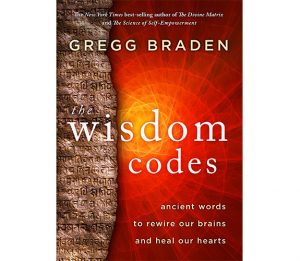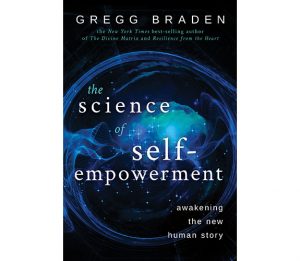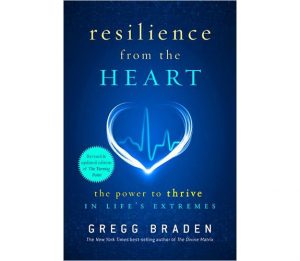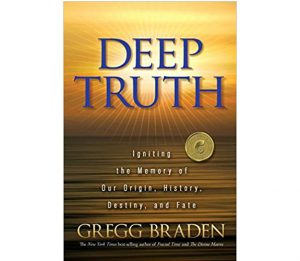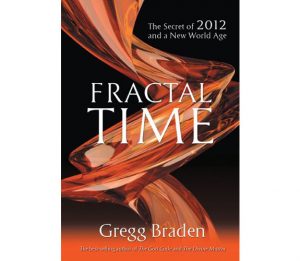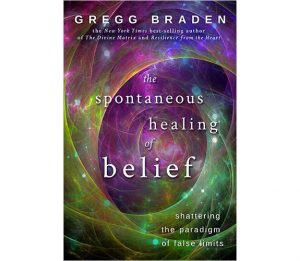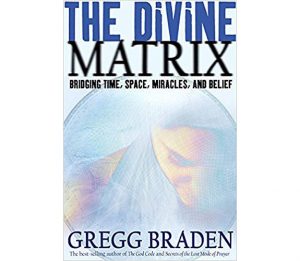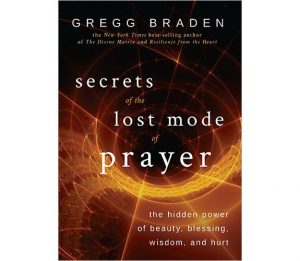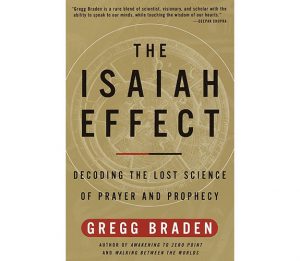Please select one of Gregg Braden’s books below to view its citations and reference section.
The Science of Self Empowerment: Resources
Previously titled Human by Design
Human by Design – 1st Edition, October 2017
PART I: The New Human Story
 Introduction
Introduction
Epigraph. Carl Sagan. Contact (New York: Simon and Schuster, 1997), p. 430.
1. There has been an explosion of new research exploring the power of human beliefs, the placebo effect, and the power of our expectations when it comes to the healing of the body. This particular example describes a randomized double-blind study that was done with a group experiencing Parkinson’s disease. Joseph Mercola. “How the Power of Your Mind Can Influence Your Healing and Recovery,” Mercola.com (March 5, 2015). Available at: http://articles.mercola.com/sites/articles/archive/2015/03/05/placebo-effect-healing-recovery.aspx.
2. Elizabeth Palermo, associate editor. “Niels Bohr: Biography & Atomic Theory,” (May 14, 2013). Available at: http://www.livescience.com/32016-niels-bohr-atomic-theory.html.
 Chapter 1: Breaking Darwin’s Spell
Chapter 1: Breaking Darwin’s Spell
Epigraph. Scott Turow. Ordinary Heroes (New York: Grand Central Publishing, 2011), p. 66.
1. Frank Newport. “In U.S., 42% Believe Creationist View of Human Origins,” Gallup.com (June 2, 2014). Available at: http://www.gallup.com/poll/170822/believe-creationist-view-human-origins.aspx.
2. Francis Crick. Life Itself: Its Origin and Nature (New York: Touchstone, 1981), p. 88.
3. Adrián Recinos. Popol Vuh: The Sacred Book of the Ancient Quiché Maya, “Creation Myth,” chapters 1–3, Delia Goetz and Sylvanus G. Morley, eds. (Norman, OK: University of Oklahoma Press, 1950), pp. 167–168. Available at: https://en.wikipedia.org/wiki/Popol_Vuh#Creation_myth. The Popol Vuh, as we know it today, is taken from the records of Francisco Ximénez, a Dominican priest, written at the turn of the 18th century. The manuscript sank into obscurity until it was “rediscovered” in 1941 by Adrián Recinos, who is generally given credit for publishing it in recent times. Recinos explains: “The original manuscript is not divided into parts or chapters; the text runs without interruption from the beginning until the end. In this translation I have followed the Brasseur de Bourbourg division into four parts, and each part into chapters, because the arrangement seems logical and conforms to the meaning and subject matter of the work. Since the version of the French Abbe is the best known, this will facilitate the work of those readers who may wish to make a comparative study of the various translations of the Popol Vuh” (Goetz xiv; Recinos 11–12; Brasseur, xv).
4. The Holy Bible: Authorized King James Version, Genesis, chapter 1, verse 26 (Cleveland, OH: World Publishing Company, 1961), p. 9.
5. The Torah: A Modern Commentary, Bereshit, chapter 1, verse 26, W. Gunther Plaut, eds. (New York: Union of American Hebrew Congregations, 1981), p. 19.
6. “Ancient Egypt: The Mythology,” EgyptianMyths.net. Available at: http://www.egyptianmyths.net/section-deities.htm.
7. These slogans (from Lucky Strike cigarettes, actor Edmund Lowe’s endorsement of Lucky Strike, and Viceroy cigarettes) were popular in tobacco ads in the early to mid-20th century. See Hadgirl. “10 Evil Vintage Cigarette Ads Promising Better Health,” Healthcare Administration Degree Programs blog. Available at: http://www.healthcare-administration-degree.net/10-evil-vintage-cigarette-ads-promising-better-health.
8. Ibid.
9. NBC TV news report (January 11, 1964) by correspondent Frank McGee. “Special Report: Smoking and Health.” Available at: https://highered.nbclearn.com/portal/site/HigherEd/flatview?cuecard=68341.
10. Terry Pratchett. A Hat Full of Sky (New York: HarperCollins, 2004). Read excerpts from the book at: https://theillustratedpage.wordpress.com/2015/07/16/review-of-a-hat-full-of-sky-by-terry-pratchett.
11. Carl Sagan, “The Backbone of Night,” Cosmos episode 7, November 9, 1980.
12. Albert Einstein, as cited by Steven Pollock, Oliver DeWolfe, and Steve Goldhaber, Physics Department, University of Colorado, Boulder. “Physics 3220: Quantum Mechanics” (Fall 2008). Available at: http://www.colorado.edu/physics/phys3220/phys3220_fa08/quotes.html.
13. Charles Darwin. On the Origin of Species by Means of Natural Selection. Available at: http://www.gutenberg.org/files/2009/2009-h/2009-h.htm.
14. For more information about Charles Darwin’s voyage aboard the HMS Beagle, please see this website: https://www.aboutdarwin.com/voyage/voyage03.html.
15. Darwin, Origin of Species, pp. 126–7.
16. Ibid., p. 219.
17. Ibid., p. 155.
18. “Evolution Series Overview,” PBS.org (2001). Available at: http://www.pbs.org/wgbh/evolution/about/overview.html.
19. Joshua Gilder. “PBS’ ‘Evolution’ Series Is Propaganda, Not Science,” WorldNetDaily.com (September 24, 2001). Available at: http://www.wnd.com/2001/09/11004.
20. Read the text of Oklahoma Senate Bill 1322, proposed by State Senator Josh Brecheen during the second session of the 55th Oklahoma State Legislature (2016) at: http://www.oklegislature.gov/BillInfo.aspx?Bill=sb1322&Session=1600.
21. “Definition of Intelligent Design,” Discovery Institute, Center for Science and Culture website (accessed January 30, 2017). Available at: http://www.intelligentdesign.org/whatisid.php.
22. Decision filed December 20, 2005, in the Dover case by the United States District Court for the Middle District of Pennsylvania. “Tammy Kitzmiller, et al., v. Dover Area School District, et al.,” National Center for Science Education website. Available at: https://ncse.com/files/pub/legal/kitzmiller/highlights/2005-12-20_Kitzmiller_decision.pdf.
23. Louis Agassiz. “Evolution and Permanence of Type,” Atlantic Monthly (January 1874), p. 10. Available at: http://www.unz.org/Pub/AtlanticMonthly-1874jan-00092.
24. Ibid., p. 12, italics added.
25. Adam Sedgwick. Spectator (March 1860). Quoted in David L. Hull, Darwin and His Critics: The Reception of Darwin’s Theory of Evolution by the Scientific Community (Cambridge, MA: Harvard University Press, 1973), pp. 155–170.
26. Louis Agassiz: His Life and Correspondence, Elizabeth C. Agassiz, eds. (Boston: Houghton Mifflin, 1893), p. 647. Available at: https://ia902606.us.archive.org/28/items/louisagassizhisl02agas/louisagassizhisl02agas.pdf.
27. Albert Fleischmann. “The Doctrine of Organic Evolution in the Light of Modern Research,” Journal of the Transactions of the Victoria Institute or Philosophical Society of Great Britain, vol. 65 (London, U.K., 1933), pp. 194– 195, 205–206, 208–9. Available at: https://biblicalstudies.org.uk/pdf/jtvi/1933_194.pdf.
28. H. S. Lipson. “A Physicist Looks at Evolution,” Physics Bulletin, vol. 31, no. 4 (May 1980), p. 138.
29. Leonard Harrison Matthews. “Introduction,” The Origin of the Species by Charles Darwin (London: J. M. Dent and Sons, 1971), pp. x–xi.
30. Fred Hoyle. “Hoyle on Evolution,” Nature, vol. 294, no. 5837 (November 12, 1981), p. 105.
31. Michael Denton. Evolution: A Theory in Crisis (Chevy Chase, MD: Adler and Adler Books, 1986), p. 358.
32. Stephen Jay Gould. “Not Necessarily a Wing,” Natural History, vol. 94, no. 14 (October 1985), pp. 12–13.
33. Wolfgang Smith. Teilhardism and the New Religion: A Thorough Analysis of the Teachings of Pierre Teilhard de Chardin (Charlotte, NC: TAN Books, 1988), p. 24.
34. “A Scientific Dissent from Darwin” is a website that contains the list launched by the Discovery Institute in 2001 of scientists throughout the world who have not accepted Darwin’s theory of evolution as fact. Available at: http://www.dissentfromdarwin.org.
35. Charles Darwin to Asa Gray, 1860. Quoted in David Masci, “Darwin and His Theory of Evolution,” Pew Research Center, Religion and Public Life (February 4, 2009). Available at: http://www.pewforum.org/2009/02/04/darwin-and-his-theory-of-evolution.
36. Henry Edward Manning. Quoted in Masci, “Darwin and His Theory of Evolution.”
37. Thomas H. Morgan. Evolution and Adaptation (New York: Macmillan Company, 1903), p. 43.
38. Darwin (Pacific Publishing Studio, 2010), p. 151.
 Chapter 2: Human by Design
Chapter 2: Human by Design
Epigraph. Harold Urey, as cited by Christian Science Monitor (January 4, 1962), p. 4.
1. “This Day in History: February 28: Lead Story: Watson and Crick Discover Chemical Structure of DNA,” History.com (accessed January 30, 2017). Available at: http://www.history.com/this-day-in-history/watson-and-crick-discover-chemical-structure-of-dna.
2. William Goodwin. “Rare Tests on Neanderthal Infant Sheds Light on Early Human Development,” Science News (April 4, 2000). Available at: https://www.sciencedaily.com/releases/2000/03/000331091126.htm.
3. “What Does It Mean to Be Human? Neanderthal Mitochondrial DNA,” Smithsonian Institution, National Museum of Natural History website (accessed January 30, 2017). Available at: http://humanorigins.si.edu/evidence/genetics/ancient-dna-and-neanderthals/neanderthal-mitochondrial-dna.
4. Igor V. Ovchinnikov, Anders Götherström, Galina P. Romanova, Vitaliy M. Kharitonov, Kerstin Lidén, and William Goodwin. “Molecular Analysis of Neanderthal DNA from the Northern Caucasus,” Nature, vol. 404 (2000), pp. 490–493. Available at: http://cogweb.ucla.edu/Abstracts/Goodwin_00.html.
5. “What Does It Mean to Be Human? Homo Sapiens,” Smithsonian Institution, National Museum of Natural History website (Accessed January 30, 2017). Available at: http://humanorigins.si.edu/evidence/human-fossils/species/homo-sapiens.
6. Lizzie Wade. “Oldest Human Genome Reveals When Our Ancestors Had Sex with Neandertals,” Science website (October 22, 2014). Available at: http://www.sciencemag.org/news/2014/10/oldest-human-genome-reveals-when-our-ancestors-had-sex-neandertals.
7. Hillary Maywell. “Neandertals Not Our Ancestors, DNA Study Suggests,” National Geographic News (May 14, 2003). Available at: http://news.nationalgeographic.com/news/2003/05/0514_030514_neandertalDNA.html.
8. Public Library of Science. “Europe’s Ancestors: Cro-Magnon 28,000 Years Old Had DNA Like Modern Humans,” ScienceDaily (July 16, 2008). Available at: http://www.sciencedaily.com/releases/2008/07/080715204741.htm.
9. Simon Tripp and Martin Grueber. “Economic Impact of the Human Genome Project,” Battelle Memorial Institute report (May 2011). Available at: https://www.battelle.org/docs/default-document-library/economic_impact_of_the_human_genome_project.pdf.
10. For an easy-to-understand description of the DNA differences between humans and our nearest primate relatives, chimpanzees, visit “DNA: Comparing Humans and Chimps,” American Museum of Natural History website (accessed January 30, 2017): http://www.amnh.org/exhibitions/permanent-exhibitions/human-origins-and-cultural-halls/anne-and-bernard-spitzer-hall-of-human-origins/understanding-our-past/dna-comparing-humans-and-chimps.
11. The term 7q31 is shorthand notation for the way scientists describe the location of a gene within a chromosome. The code is simple and made of three parts. Part 1: The first number tells us the big picture of which chromosome the gene is located within. Part 2: The letter tells us which of the two arms that make up a chromosome the gene is on: the short (or p) arm, or the long (or q) arm. Part 3: The latter number tells us the gene’s actual position on the chromosome, as determined by the number of dark and light bands that are visible using a microscope on specially stained samples. In this case the gene is on chromosome 7, on the long q arm, at position 31, when counting from the center point (centromere) of the chromosome.
12. “Study Links Evolution of Single Gene to Human Capacity for Language,” Emory University, Yerkes National Primate Research Center press release (November 11, 2009). Available at: http://www.yerkes.emory.edu/about/news/neuropharmacology_neurologic_diseases/gene_language_capacity.html.
13. Ibid.
14. Wolfgang Enard, interviewed by Helen Briggs. “First Language Gene Discovered,” BBC News World Edition (August 14, 2002). Available at: http://news.bbc.co.uk/2/hi/science/nature/2192969.stm.
15. Ibid.
16. Michael Purdy. “Human Chromosomes 2, 4 Include Gene Deserts, Signs of Chimp Chromosome Merger,” Washington University in St. Louis Source (April 6, 2005). Available at: https://source.wustl.edu/2005/04/human-chromosomes-2-4-include-gene-deserts-signs-of-chimp-chromosome-merger. See also J. W. Ijdo, A. Baldini, D. C. Ward, S. T. Reeders, and R. A. Wells. “Origin of Human Chromosome 2: An Ancestral Telomere-Telomere Fusion,” Proceedings of the National Academy of Sciences USA, vol. 88, no. 20 (October 15, 1991), pp. 9051–5. Available at: https://www.ncbi.nlm.nih.gov/pmc/articles/PMC52649.
17. J. W. Ijdo et al. Italics added. While some scientists continue to object to the conclusion that human chromosome 2 is the result of an ancient gene fusion, the evidence clearly points to such a fusion. To summarize, the evidence states that: (1) the fact that the DNA sequences of the separate chimp genes are nearly identical to those found combined in human chromosome 2; (2) the presence of a second unused “vestigial” centromere (the point that separates the long and short arms of the gene), which would be expected if two genes, each with one centromere, had merged into a single unit; and (3) the presence of vestigial telomeres—the protective sequence of DNA normally found at the ends of chromosomes—found midgene in the q13 band, rather than at the end of the chromosome.
18. For a detailed description of functions associated with human chromosome 2, visit “Chromosome 2 (Human),” Wikipedia (accessed January 30, 2017). Available at: https://en.wikipedia.org/wiki/Chromosome_2_(human).
19. Ibid.
20. J. W. Ijdo, et al.
21. The Expanded Quotable Einstein, Alice Calaprice, ed. (Princeton, NJ: Princeton University Press, 2000), p. 204.
22. Alfred Russel Wallace. Contributions to the Theory of Natural Selection (New York: Macmillan, 1870), p. 356. Available at: https://ia601406.us.archive.org/32/items/contributionstot00wall/contributionstot00wall.pdf.
 Chapter 3: The Brain in the Heart
Chapter 3: The Brain in the Heart
Epigraph. Gary E. R. Schwartz and Linda G. S. Russek. Foreword to Paul P. Pearsall, The Heart’s Code: Tapping the Wisdom and Power of Our Heart Energy (New York: Broadway Books, 1998), p. xiii.
1. “Cro-Magnon,” Wikipedia (accessed January 30, 2017). Available at: https://en.wikipedia.org/wiki/Cro-Magnon.
2. Ibid.
3. “Neanderthal Anatomy,” Wikipedia (accessed January 30, 2017). Available at: https://en.wikipedia.org/wiki/Neanderthal_anatomy.
4. Joshua Batson. “Watch 80,000 Neurons Fire in the Brain of a Fish,” Wired (July 28, 2014). Available at: https://www.wired.com/2014/07/neuron-zebrafish-movie.
5. “Anatomy of the Brain,” Mayfield Clinic, Brain and Spine Institute (accessed January 30, 2017). Available at: http://www.mayfieldclinic.com/PE-AnatBrain.htm#.VYTaBFVViko.
6. “Amazing Heart Facts,” Arkansas Heart Hospital (accessed January 30, 2017). Available at: http://www.arheart.com/cardiovascular-health/amazing-heart-facts.
7. The languages of Hebrew, Aramaic, and ancient Greek have contributed to the Bible we know today. When its passages are translated into English, the exact number of times a particular word occurs in the Bible varies depending upon the translation (for example, the Authorized King James Version or the New American Standard). To learn the number of times the word heart occurs in different versions of the Bible, see “Word Counts: How Many Times Does a Word Appear in the Bible?” Christian Bible Reference Site: http://www.christianbiblereference.org/faq_WordCount.htm.
8. The Holy Bible, Authorized King James Version, Proverbs, chapter 20, verse 5 (Cleveland, OH: World Publishing Company, 1961), p. 534.
9. Rodney Ohebsion. “Native American Proverbs, Quotes and Chants,” RodneyOhebsion.com (accessed January 30, 2017). Available at: http://www.rodneyohebsion.com/native-american-proverbs-quotes.htm.
10. Daisaku Ikeda. “The Wisdom of the Lotus Sutra,” Soka Gakki International (accessed January 30, 2017). Available at: http://www.sgi.org/about-us/president-ikedas-writings/the-wisdom-of-the-lotus-sutra.html.
11. Ibid.
12. See Ralph Marinelli, Branko Fuerst, Hoyte van der Zee, Andrew McGinn, and William Marinelli. “The Heart Is Not a Pump,” Frontier Perspectives (Fall/ Winter 1995). Available at: http://www.rsarchive.org/RelArtic/Marinelli.
13. J. Andrew Armour. Neurocardiology: Anatomical and Functional Principles, HeartMath Research Center, Institute of HeartMath, eBook (2003).
14. Ibid.
15. Ibid.
16. Ibid.
17. The Quick Coherence® Technique for Adults. Available at: https://www.heartmath.org/resources/heartmath-tools/quick-coherence-technique-for-adults.
18. Armour. Neurocardiology.
19. “Fifty Spiritual Homilies of Saint Macarius the Egyptian: Homily 43:7,” e-Catholic 2000 (accessed March 22, 2017). Available at: http://www.ecatholic2000.com/macarius/untitled-46.shtml#_Toc385610658.
20. Tony Long. “Dec. 3, 1967: Patient Dies, but First Heart Transplant a Success,” Wired (December 3, 2007). Available at: https://www.wired.com/2007/12/dayintech-1203.
21. “Artificial Hearts May Help Patients Survive until Transplant,” American College of Cardiology press release (March 27, 2014). Available at: http://www.acc.org/about-acc/press-releases/2014/03/27/12/53/gurudevan-artificial-heart-pr.
22. Ibid.
23. Claire Sylvia. A Change of Heart: A Memoir (New York: Warner Books, 1997).
24. Ibid., p. 226.
25. Paul Pearsall. The Heart’s Code (New York: Broadway Books, 1999), Introduction.
26. Charles E. Gross. “Leonardo da Vinci on the Brain and the Eye,” Neuroscientist, vol. 3, no. 5 (September 1, 1997), pp. 347–54. Available at: http://journals.sagepub.com/doi/pdf/10.1177/107385849700300516.
27. Clare Boothe Brokaw (Clare Boothe Luce). Stuffed Shirts (New York, Horace Liveright, 1931), p. 239.
28. Chad Boutin. “Snap judgments decide a face’s character, psychologist finds,” Princeton University (August 22, 2006). Available at: https://www.princeton.edu/main/news/archive/S15/62/69K40/index.xml?section=topstories.
29. My affiliation with the Institute of HeartMath dates to 1995. During that time I’ve shared keynote presentations and weekend seminars with Howard Martin, executive vice president, and Debbie Rozman, Ph.D., president and co-CEO; and I have served on the steering committee for the Global Coherence Initiative Project since its inception in 2008. For a list of staff and advisors, go to: https://www.heartmath.com/heartmath-team.
30. Rollin McCraty, Mike Atkinson, and Raymond Trevor Bradley. “Electrophysiological Evidence of Intuition: Part 1. The Surprising Role of the Heart,” Journal of Alternative and Complementary Medicine, vol. 10, no. 1 (June 2004), pp. 133–143.
 Chapter 4: The New Human Story
Chapter 4: The New Human Story
Epigraph. Brené Brown. Own Our History. Change the Story (June 18, 2015). Available at: http://brenebrown.com/2015/06/18/own-our-history-change-the-story.
1. Kristen Philipkoski. “Researchers Cut Gene Estimate,” Wired (February 12, 2001). Available at: http://archive.wired.com/science/discoveries/news/2001/02/41749.
2. “The Human Genome Is More and Less Than We Expected to Find,” The Tech Museum of Innovation (2013). Available at: http://genetics.thetech.org/original_news/news14.
3. Guilherme Neves, Jacob Zucker, Mark Daly, and Andrew Chess. “Stochastic Yet Biased Expression of Multiple Dscam Splice Variants by Individual Cells,” Nature Genetics, vol. 36, no. 3 (February 1, 2004), pp. 240–6.
4. Victor A. McKusick. As quoted in “2001: Publication of the Human Genome Sequence,” Genome News Network. Available at: http://www.genomenewsnetwork.org/resources/timeline/2001_human_pub.php.
5. Craig Venter. As quoted by Tom Abate. “Genome Discovery Shocks Scientists,” San Francisco Chronicle (February 11, 2001). Available at: http://www.sfgate.com/news/article/Genome-Discovery-Shocks-ScientistsGenetic-2953173.php.
6. Albert A. Michelson and Edward W. Morley. “On the Relative Motion of the Earth and the Luminiferous Ether,” American Journal of Science, vol. 34, no. 203 (November 1887), pp. 333–45.
7. E. W. Silvertooth. “Special Relativity.” Nature, vol. 322, no. 6080 (August 1986), p. 590.
8. Ilya Prigogine, Gregoire Nicolis, and Agnes Babloyantz. “Thermodynamics of Evolution,” Physics Today, vol. 25, no. 11 (November 1972), pp. 23–8.
9. Marcel Golay and Frank Salisbury. As quoted by Henry M. Morris. “Probability and Order versus Evolution,” Acts and Facts, vol. 8, no. 7 (1979). Available at: http://www.icr.org/article/probability-order-versus-evolution.
10. Fred Hoyle and N. Chandra Wickramasinghe. Evolution from Space (London: J. M. Dent & Sons, 1981).
11. Fred Hoyle. “Hoyle on Evolution,” Nature, vol. 294, no. 5837 (November 12, 1981), p. 105.
12. John Black. “The Origins of Human Beings according to Ancient Sumerian Texts,” Ancient Origins (January 30, 2013). Available at: http://www.ancientorigins.net/human-origins-folklore/origins-human-beings-according-ancient-sumerian-texts-0065.
13. Louis Ginzberg. The Legends of the Jews, vol. 1, From Creation to Jaco (1938), p. 54. Available at: http://www.gutenberg.org/ebooks/1493.
14. The Holy Qur’an, with English Translation and Commentary, Pilgrimage, chapter 22, verse 5. Maulana Muhammad Ali, ed. (Columbus, OH: Ahmadiyah Anjuman Isha’at Islam, 1917), p. 648.
15. Ibid., chapter 25, verse 54, p. 705.
16. Ibid., p. 648.
17. The Holy Bible, Authorized King James Version, Genesis, chapter 2, verse 7 (Cleveland, OH: World Publishing Company, 1961), p. 10.
18. Charles C. Mann. 1491: New Revelations of the Americas before Columbus (New York: Alfred A. Knopf, 2005), pp. 199–212.
19. Popol Vuh, Norine Polio, ed., Yale-New Haven Teachers Institute. Available at: http://teachersinstitute.yale.edu/curriculum/units/1999/2/99.02.09.x.html.
20. Duane Elgin. “Why We Need to Believe in a Living Universe,” Huffington Post blog (May 15, 2011). Available at: http://www.huffingtonpost.com/duaneelgin/living-universe_b_862220.html.
21. Ibid.
22. Ibid.
23. Ibid.
24. Ray Bradbury. “G. B. S. Mark V,” in I Sing the Body Electric! And Other Stories (New York: HarperPerennial, 2001), p. 275.
25. Albert Einstein. Letter to Robert S. Marcus, political director of the World Jewish Congress, on the occasion of his son passing away from polio (February 12, 1950), emphasis added.
26. Karl Jaspers. The Idea of the University (London: Peter Owen, 1965), p. 30. As cited by James Cowan. “Climate Change: A Humanist Response,” epigraph (June 2015). Available at: http://www.academia.edu/12372530/Climate_Change_a_humanist_response.
PART II: AWAKENING THE NEW HUMAN STORY
 Chapter 5: We’re “Wired” for Connection
Chapter 5: We’re “Wired” for Connection
Epigraph. Mitch Albom. The Five People You Meet in Heaven (New York: Hachette, 2003), p. 50.
1. Dean Koontz, as cited on Goodreads. Available at: http://www.goodreads.com/quotes/95562-intuition-is-seeing-with-the-soul.
2. “Mother-Baby Study Supports Heart-Brain Interactions,” HeartMath Institute (April 20, 2008). Available at: https://www.heartmath.org/articles-of-theheart/science-of-the-heart/mother-baby-study-supports-heart-brain-interactions.
3. Ibid.
4. Ibid.
5. Ibid.
6. “Captured Pilot’s Mother Felt Something Was Wrong,” CNN.com (March 24, 2003). Available at: http://www.cnn.com/2003/US/South/03/24/sprj.irq.pilot.family.
7. Ibid.
8. Ibid.
9. Alan Cowell and Douglas Jehl. “Luxor Survivors Say Killers Fired Methodically,” New York Times (November 24, 1997). Website: http://www.nytimes.com/1997/11/24/world/luxor-survivors-say-killers-fired-methodically.html.
10. Albert Einstein. Letter to Robert S. Marcus (February 12, 1950).
11. The Dalai Lama. The Art of Happiness: A Handbook for Living, 10th anniversary edition (New York: Riverhead Books, 2009), p. 119.
12. Joanna Macy, “The Bodhisattva,” excerpted from a talk at Barre Center for Buddhit Studies, “The WIngs of the Bodhisatttva,” Insight Magazine (Spring/Summer 2001). Available at http://www.joanamacy.net/the-bodhisattva.html.
 Chapter 6: We’re “Wired” for Healing and Long Life
Chapter 6: We’re “Wired” for Healing and Long Life
Epigraph. Neel Burton. Available at: http://www.goodreads.com/quotes/7280473-many-things-can-prolong-your-life-but-only-wisdom-can.
1. The Holy Bible, Authorized King James Version, Genesis, chapter 6, verse 10 (Cleveland, OH: World Publishing Company, 1961), p. 13.
2. Ibid., Genesis, chapter 5, verse 24, p. 12.
3. Ibid., Genesis, chapter 6, verse 3, p. 13.
4. “The Nobel Prize in Physiology or Medicine 2009,” Nobelprize.org press release (October 5, 2009). Available at: https://www.nobelprize.org/nobel_prizes/medicine/laureates/2009/press.html.
5. Ewen Callaway. “Telomerase Reverses Aging Process,” Nature News (November 28, 2010). Available at: http://www.nature.com/news/2010/101128/full/news.2010.635.html
6. Ibid.
7. Kristin Kirkpatrick. “Should I Stop Eating Eggs to Control Cholesterol? (Diet Myth 4),” ClevelandClinic.org (August 16, 2012). Available at: https://health.clevelandclinic.org/2012/08/should-i-stop-eating-eggs-to-control-cholesterol-diet-myth-4.
8. John Phillip. “Targeted Nutrients Naturally Extend Telomere Length and Provide Anti-aging Effect,” Natural News (December 29, 2011). Available at: http://www.naturalnews.com/034513_telomeres_longevity_nutrition.html. Original study available at http://jn.nutrition.org/content/139/7/1273.full.pdf.
9. Elissa S. Epel, Elizabeth H. Blackburn, Jue Lin, Firdaus S. Dhabhar, Nancy E. Adler, Jason D. Morrow, and Richard M. Cawthon. “Accelerated Telomere Shortening in Response to Life Stress,” Proceedings of the National Academy of Sciences of the United States of America, vol. 101, no. 49 (September 28, 2004), pp. 17312–5. Available at: http://www.pnas.org/content/101/49/17312.long.
10. “Essenes,” Wikipedia (accessed January 30, 2017). Available at: https://en.wikipedia.org/wiki/Essenes.
11. The Essene Gospel of Peace, Edmond Bordeaux Szekely, ed. and trans. (Matsqui, BC: International Biogenic Society, 1937), p. 39.
12. There are legal and cultural definitions for precisely what food is. I’m using a Google definition that addresses the common and practical aspects of food as it’s understood in our society. See https://www.google.com/webhp?sourceid=chrome-instant&ion=1&espv=2&ie=UTF-8#q=definition+of+food.
13. “Li Ching-Yuen,” Wikipedia (accessed January 30, 2017). Available at: https://en.wikipedia.org/wiki/Li_Ching-Yuen.
14. “Li Ching-Yun Dead; Gave His Age as 197,” New York Times (May 6, 1933); available at: http://query.nytimes.com/gst/abstract.html?res=9503E4DF1538E333A25755C0A9639C946294D6CF; and “China: Tortoise-Pigeon-Dog,” Time (May 15, 1933); available at: http://content.time.com/time/magazine/article/0,9171,745510,00.html.
15. “Tortoise-Pigeon-Dog,” Time.
16. Martin Patience, “World’s ‘Oldest’ Person in Israel,” BBC News (February 15, 2008). Available at: http://news.bbc.co.uk/2/hi/middle_east/7247679.stm.
17. “Life Expectancy for Social Security,” Social Security Administration (accessed January 30, 2017). Available at: https://www.ssa.gov/history/lifeexpect.html.
18. Romeo Vitelli. “When a Parent Loses a Child,” Psychology Today (February 4, 2013). Available at: https://www.psychologytoday.com/blog/media-spotlight/201302/when-parent-loses-child.
19. American Psychological Association. “What Is Resilience?” Psych Central (accessed March 20, 2017). Available at: http://psychcentral.com/lib/2007/what-is-resilience
20. “What Is Resilience?” Stockholm Resilience Centre (July 4, 2008). Available at: http://www.stockholmresilience.org/research/research-videos/2011-12-01-what-is-resilience.html.
21. “Heart Rate Variability,” HeartMath Institute (October 27, 2014). Available at: https://www.heartmath.org/articles-of-the-heart/the-math-of-heartmath/heart-rate-variability.
22. Rollin McCraty, Raymond Trevor Bradley, and Dana Tomasino. “The Resonant Heart,” Shift (December 2004–February 2005), pp. 15–19. Available at: https://www.heartmath.org/research/research-library/relevant-publications/the-resonant-heart.
23. Doc Childre and Deborah Rozman. Transforming Stress: The HeartMath Solution for Transforming Worry, Fatigue, and Tension (Oakland, CA: New Harbinger Publications, 2005), p. 99.
 Chapter 7: We’re “Wired” for Destiny
Chapter 7: We’re “Wired” for Destiny
Epigraph. William Jennings Bryan, from “America’s Mission,” a speech he delivered at a banquet given by the Virginia Democratic Association in Washington, DC, on February 22, 1899. Available at: https://archive.org/stream/speechesofwillia02bryauoft/speechesofwillia02bryauoft_djvu.txt.
1. Forrest Gump (1994), directed by Robert Zemeckis. Written by Eric Roth, based on the novel Forrest Gump by Winston Groom (New York: Vintage Books, 1986).
2. Aldous Huxley. Brave New World (London, U.K.: Chatto and Windus, 1931).
3. H. G. Wells. Men Like Gods (London, U.K.: Cassell & Company, 1921).
4. Carnegie Endowment for International Peace Records, 1910–1954, Carnegie Collections Rare Book and Manuscript Library, Columbia University. Available at: http://www.columbia.edu/cu/lweb/eresources/archives/rbml/CEIP/index.html?ceipFBio.html&1.
5. “11 Myths about Global Hunger,” World Food Programme (October 21, 2011). Available at: https://www.wfp.org/stories/11-myths-about-global-hunger.
6. “By the Numbers: Hunger in the World,” UFCW Canada (United Food and Commercial Workers Union 2017), Available at: http://www.ufcw.ca/index.php?option=com_content&view=article&id=3061:by-the-numbers-hunger-in-the-world&catid=271&Itemid=6&lang=en.
7. Richard Martin. “Meltdown-Proof Reactors Get a Safety Check in Europe,” MIT Technology Review (September 4, 2015). Available at: https://www.technologyreview.com/s/540991/meltdown-proof-nuclear-reactors-get-a-safety-check-in-europe.
8. Ibid.
9. “Indian Point Energy Center,” Wikipedia (accessed January 30, 2017). Available at: https://en.wikipedia.org/wiki/Indian_Point_Energy_Center.
10. Doug Stephens. “Shared Interests: The Rise of Collaborative Consumption,” Retail Prophet (November 26, 2013). Available at: http://www.retailprophet.com/blog/shared-interests-the-rise-of-collaborative-consumption.
11. Stephen Hawking, from an interview published in a German magazine (translator unknown). Von Klaus Franke and Henry Glass. “Wir alle wollen wissen, woher wir kommen,” Der Spiegel, vol. 42 (October 17, 1988). Available at: http://www.spiegel.de/spiegel/print/d-13542088.html.
12. Richard Dawkins. “Review of Blueprints: Solving the Mystery of Evolution,” New York Times (April 9, 1989), p. 34.
13. Neil Munro. “Poll: Race Relations Have Plummeted Since Obama Took Office,” Daily Caller (July 25, 2013). Available at: http://dailycaller.com/2013/07/25/race-relations-have-plummeted-since-obama-took-office-according-to-poll.
14. Eric Hobsbawm, “War and Peace in the 20th Century,” London Review of Books, vol. 24, no. 4 (February 21, 2002). Hobsbawm’s statistics show that by the end of the 20th century, over 187 million people had lost their lives to war. Available at: https://www.lrb.co.uk/v24/n04/eric-hobsbawm/war-and-peace-in-the-20th-century.
15. Matthew White. “Worldwide Statistics of Casualties, Massacres, Disasters and Atrocities,” The Historical Atlas of the Twentieth Century. Available at: http://necrometrics.com/index.htm.
16. Jonathan Steele. “The Century That Murdered Peace,” Guardian (December 11, 1999). Available at: https://www.theguardian.com/world/1999/dec/12/theobserver4.
17. “Convention on the Prevention and Punishment of the Crime of Genocide,” UN General Assembly resolution (December 9, 1948). Available at: http://www.ohchr.org/EN/ProfessionalInterest/Pages/CrimeOfGenocide.aspx.
18. Richard Weikart. From Darwin to Hitler: Evolutionary Ethics, Eugenics and Racism in Germany (New York: Macmillan, 2006).
19. See Stéphane Courtois, Nicolas Werth, Jean-Louis Panné, Andrzej Paczkowski, Karel Bartošek, and Jean-Louis Margolin. The Black Book of Communism. Jonathan Murphy and Mark Kramer, trans. (Cambridge, MA: Harvard University Press, 1999), p. 491.
20. See Adolf Hitler. “Nation and Race,” Mein Kampf, vol. 1: A Reckoning (1925). Available at: http://www.hitler.org/writings/Mein_Kampf/mkv1ch11.html.
21. “Past Genocides and Mass Atrocities.” United to End Genocide. Available at: http://endgenocide.org/learn/past-genocides.
22. Charles Darwin, On the Origin of Species by Means of Natural Selection (Seattle: Pacific Publishing Studio, 2010), p. 133.
23. Hitler, Mein Kampf.
24. Charles Darwin. The Descent of Man (Amherst, NY: Prometheus Books, 1998), p. 110.
25. Peter Kropotkin. Mutual Aid: A Factor of Evolution (1902) (Boston: Porter Sargent, 1976), p. 14.
26. John M. Swomley. “Violence: Competition or Cooperation,” Christian Ethics Today, vol. 26 (February 2000), p. 20. Available at: http://pastarticles.christianethicstoday.com/cetart/index.cfm?fuseaction=Articles.main&ArtID=300.
27. Ibid.
28. Ibid. Quoted in Ronald Logan. “Opening Address of the Symposium on the Humanistic Aspects of Regional Development,” Prout Journal, vol. 6, no. 3 (September 1993).
29. Alfie Kohn. Quoted in Ronald Logan, “Opening Address.”
30. Carl Sandburg. The People, Yes (1936) (New York: Mariner Books, 1990), p. 43.
31. Simone Robers, Anlan Zhang, Rachel E. Morgan, and Lauren Musu-Gillette. Indicators of School Crime and Safety: 2014, a report by the National Center for Education Statistics, Institute of Education Sciences (July 2015). Available at: https://nces.ed.gov/pubs2015/2015072.pdf.
32. “Suicide of Jadin Bell,” Wikipedia (accessed January 30, 2017). Available at: https://en.wikipedia.org/wiki/Suicide_of_Jadin_Bell.
33. Ibid.
34. “Cyberbullying and Social Media,” Megan Meier Foundation (accessed March 21, 2017). Available at: http://www.meganmeierfoundation.org/cyberbullying-social-media.html; Joe Vallese. “‘Audry and Daisy’ Exposes the Trauma of Teenage Sexual Assault and Slut Shaming,” Vice (September 23, 2016). Available at: https://www.vice.com/en_us/article/audrie-and-daisy-netflix-documentary-social-media-sexual-assault.
35. Haeyoun Park and Iaryna Mykhyalyshyn. “L.G.B.T. People Are More Likely to Be Targets of Hate Crimes Than Any Other Minority Group,” New York Times (June 16, 2016). Available at: https://www.nytimes.com/interactive/2016/06/16/us/hate-crimes-against-lgbt.html.
36. “Matthew Shepard,” Wikipedia (accessed January 30, 2017). Available at: https://en.wikipedia.org/wiki/Matthew_Shepard.
37. In addition to offering a factual account of the murder of James Byrd, Jr., the Wikipedia entry “James Byrd, Jr.” (accessed on January 30, 2017) describes the federal legislation that resulted from his death and the death of Matthew Shepard, the Hate Crimes Prevention Act. Available at: https://en.wikipedia.org/wiki/Murder_of_James_Byrd_Jr.
38. A transcript of testimony presented to the British House of Commons by Deputy Speaker Natascha Engel. “DAESH: Genocide of Minorities,” House of Commons Hansard, vol. 608 (April 20, 2016). Available at: https://hansard.parliament.uk/commons/2016-04-20/debates/16042036000001/DaeshGenocideOfMinorities.
39. Ibid.
40. “FBI Releases 2014 Hate Crime Statistics,” FBI National Press Office, Washington, DC (November 16, 2015). Available at: https://www.fbi.gov/news/pressrel/press-releases/fbi-releases-2014-hate-crime-statistics.
41. Ibid.
42. Tara Lawley-Bergey. “‘My Heart Died’: A Sister Writes about Losing Her Brother to a Drug Overdose,” NBC10 (February 8, 2016). Available at: http://www.nbcphiladelphia.com/news/local/My-Heart-Died-A-Sister-Writes-About-Losing-Her-Brother-to-a-Drug-Overdose-367969281.html.
43. Ibid.
44. Ibid.
45. Rachel Carson was a marine biologist and conservationist whose 1962 book, Silent Spring (New York: Houghton Mifflin), originally published as a series of articles in The New Yorker, catapulted the environmental movement into mainstream awareness and eventually led to a ban on pesticides such as DDT.
46. “Rose Schneiderman,” Wikipedia (accessed January 30, 2017). Available at: https://en.wikipedia.org/wiki/Rose_Schneiderman.
47. “Domestic Violence Statistics,” Hope Rising (accessed January 20, 2017). Available at: http://hoperisingtx.org/about/domestic-violence-statistics.
48. Jim Yardley. “Report on Deadly Factory Collapse in Bangladesh Finds Widespread Blame,” New York Times (May 22, 2013). Available at: http://www.nytimes.com/2013/05/23/world/asia/report-on-bangladesh-building-collapse-finds-widespread-blame.html.
49. Albert Schweitzer. Reverence for Life, Reginald H. Fuller, trans. (New York: Harper and Row, 1969).
50. Ibid.
51. Desmond Tutu. “Made for Goodness,” Huffington Post (March 13, 2012). Available at: http://www.huffingtonpost.com/desmond-tutu/made-for-goodness_b_1199864.html.
 Chapter 8: Where Do We Go from Here?
Chapter 8: Where Do We Go from Here?
Epigraph. Henry Miller. Big Sur and the Oranges of Hieronymus Bosch (New York: New Directions, 1957), p. 25.
1. The precise language of this statement, though commonly attributed to Chief Seattle, has recently come into question. While the words may vary, the essence of what is attributed to him is consistent with his thinking, as evidenced in the 1854 speech he is most widely known for. Speech with commentary by Walt Crowley available at: http://www.historylink.org/File/1427.
2. Kahlil Gibran. The Prophet (New York: Alfred A. Knopf, 1963), p. 28.

